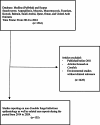Non-Candida mycosis in Gulf Cooperation Council (GCC) countries: perspective of a low-incidence region
- PMID: 39988654
- PMCID: PMC11849344
- DOI: 10.1186/s12879-025-10680-5
Non-Candida mycosis in Gulf Cooperation Council (GCC) countries: perspective of a low-incidence region
Abstract
Background: Fungal pathogens are ubiquitous microorganisms that are implicated in a wide range of infections, affecting individuals with underlying health conditions and immune suppression therapy; however, immunocompetent individuals may also be at risk. Among these infections, many are caused by molds and yeasts other than Candida and are recognized in clinical practice, such as aspergillosis, mucormycosis, fusariosis, phaeohyphomycosis, and basidiobolomycosis, among others, each presents different clinical manifestations and requires clinical management specific to the site of involvement. Although pathogenic fungal contaminants and potential sources of mycosis in humans are plentiful in Gulf Cooperation Council (GCC) countries, epidemiological reports regarding mycosis in the region are scarce.
Aim: The aim of this review is to shed some light on the epidemiology of clinically associated molds and yeasts other than Candida and to survey all related case reports and epidemiological studies conducted in the GCC over the past 10 years.
Methods: A comprehensive search of the Medline (PubMed) and Scopus databases was conducted using the following keywords: Aspergillosis, Mycosis, Mucormycosis, Fusarium, Kuwait, Bahrain, Saudi Arabia, Qatar, Oman and the United Arab Emirates. A timeframe was set to include only articles that were published from 2014 to 2024.
Results: One hundred thirty-five of the 1563 articles examined fulfilled the purpose of this review. Most studies were in Saudi Arabia (45%), Qatar (18%) and Kuwait (16%). Mucormycosis, aspergillosis, phaeohyphomycosis and basidiobolomycosis were among the most commonly reported fungal infections in the GCC, with corresponding mortality rates of 53%, 37%, 69% and 24%, respectively. The average estimations of non-Candida fungal infections indicate a low regional incidence in comparison with global estimations.
Conclusion: Awareness and a high index of suspicion are warranted in successfully managing non-Candida mycosis. More specific immunological and molecular markers are needed for differential diagnosis to rule out fungal infections. Additionally, incorporating non-Candida mycosis-related antifungal resistance surveys in GCC national surveillance efforts should be enforced, especially when considering the increase in global mycosis rates.
Keywords: Fungal infections; Gulf Cooperation Council; Invasive; Molds; Mycosis.
© 2025. The Author(s).
Conflict of interest statement
Declarations. Ethics approval and consent to participate: Not applicable. Consent for publication: Not applicable. Competing interests: The authors declare no competing interests. Clinical Trial. Not applicable.
Figures
Similar articles
-
Systematic thematic review of e-health research in the Gulf Cooperation Council (Arabian Gulf): Bahrain, Kuwait, Oman, Qatar, Saudi Arabia and United Arab Emirates.J Telemed Telecare. 2017 May;23(4):452-459. doi: 10.1177/1357633X16647894. Epub 2016 May 28. J Telemed Telecare. 2017. PMID: 27236702
-
Hemodialysis delivery, dialysis dose achievement, and vascular access types in hemodialysis patients from the Gulf Cooperation Council countries enrolled in the dialysis outcomes and practice patterns study phase 5 (2012-2015).Saudi J Kidney Dis Transpl. 2016 Nov;27(6 Suppl 1):S42-50. doi: 10.4103/1319-2442.194889. Saudi J Kidney Dis Transpl. 2016. PMID: 27991478
-
Ecological study of breast cancer incidence among nationals and nonnationals in the Gulf Cooperation Council countries.East Mediterr Health J. 2023 Jan 19;29(1):40-48. doi: 10.26719/emhj.23.005. East Mediterr Health J. 2023. PMID: 36710613
-
Asthma control factors in the Gulf Cooperation Council (GCC) countries and the effectiveness of ICS/LABA fixed dose combinations: a dual rapid literature review.BMC Public Health. 2020 Aug 8;20(1):1211. doi: 10.1186/s12889-020-09259-3. BMC Public Health. 2020. PMID: 32770967 Free PMC article. Review.
-
A theory-informed systematic review to understand physical activity among women in Gulf Cooperation Council countries.BMC Public Health. 2023 May 30;23(1):1009. doi: 10.1186/s12889-023-15725-5. BMC Public Health. 2023. PMID: 37254154 Free PMC article.
Cited by
-
Acute lymphoblastic leukemia with Fusarium solani infection: a case report.Front Med (Lausanne). 2025 Aug 1;12:1561843. doi: 10.3389/fmed.2025.1561843. eCollection 2025. Front Med (Lausanne). 2025. PMID: 40823577 Free PMC article.
References
-
- Denning DW. Global incidence and mortality of severe fungal disease. Lancet Infect Dis. 2024. Epub 2024/01/16. - PubMed
-
- (WHO) WHO. WHO fungal priority pathogens list to guide research, development and public health action. Geneva: World Health Organization; 2022.
Publication types
MeSH terms
Substances
LinkOut - more resources
Full Text Sources
Medical
Miscellaneous


